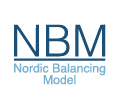The Nordic TSOs have updated the NBM roadmap based on further analysis and to meet the response from the stakeholder consultation. The revised roadmap for the Nordic Balancing Model introduces a period of parallel operation before the new 15 minutes imbalance settlement is proposed to go live in Q2 2023.
-The new Nordic balancing model implies complex and fundamental changes in the operations of the power system. We acknowledge the need for a safe transition, and a parallel operations period is an important tool in this respect, says program director Jakob Aldrin.
To mitigate climate change the energy sector have to change, and there will be comprehensive changes within both production and consumption of energy in the coming years. The Nordic TSOs; Svenska kraftnät, Energinet, Fingrid and Statnett, are developing a comprehensive restructuring of operation of the power system within the NBM program). The restructuring is necessary to uphold socio economic value of +200 million euro per year from the common Nordic balancing markets and operation, and to ensure integration of renewable energy and coupling with European balancing market platforms. The roadmap is dependent on several approval processes by Nordic regulatory authorities (NRAs).
-For the transmission system operators, the changes imply e.g. handling a rapidly growing amount of data, and there is a need for systems prepared for this situation combined with an increasing efficiency and safeguarding secure operations of the power system, Aldrin tells.
The NBM program will develop and implement Nordic Balancing Market design, operational processes and associated IT-tools needed in a future power system. Some external milestones in the NBM program are, in addition to 15 minutes imbalance settlement period, transition to a single price model and common Nordic FRR balancing capacity markets. A roadmap including timeline for different milestones in the program has been subject for consultation among stakeholders.
– Predictability is a key word, says Aldrin. Our stakeholders have told us that they prefer a realistic roadmap, and they request transparency and dialogue throughout the NBM planning and implementation.
Further work will increase insight in the needed changes ahead. Experience from other sectors show that automating processes are hard to plan in detail up-front. The parallel operation is introduced to make sure that new and automated processes for mFRR energy activation market are stabilized before going to 15 minutes imbalance settlement period. This means that stakeholders also need to be prepared for changes before the parallel operation.
-We will learn throughout the development of the NBM program and there will be changes, says Aldrin.
The NBM program will involve stakeholders, and update on the progress in our already established arenas for stakeholder involvement like the Nordic stakeholder reference group, various seminars and workshops as well as the NBM web site.
The NBM program execution is depending on many decisions that are to be made by the Nordic regulatory authorities (NRAs). This includes e.g approval for method on single pricing and the final go-live date for 15 min ISP. Nordic TSOs will start the formal derogation process for 15 minutes ISP towards NRAs in Q1 2020.
Key NBM building blocks
Single price model
The single price model will, according to the roadmap, be introduced in Q2, 2021 which is in line with the regulation. The implementation model of single pricing is, however, depending on that TSOs and stakeholder will find mitigating measures to avoid self-balancing overreactions by market players, as this is an operational concern to the TSOs. Single price news from 2 October.
Nordic FRR balancing capacity markets
FRR balancing capacity markets are important to efficiently ensure necessary reserves to maintain operational security. Increased aFRR capability in the Nordic region is needed for a safe transition to the new balancing model based on 15-minutes imbalance settlement period. The most optimistic timeline for a common Nordic aFRR (automatic frequency restoration reserve) capacity market is Q3, 2020, and more information about expected go live will be provided during Q1 2020. Link to news article on the NBM web site.
A common Nordic mFRR (manual frequency restoration reserve) capacity market will not be prioritized before transition to 15 minutes imbalance settlement, but national mFRR capacity markets will be developed earlier, based on national needs.
mFRR energy activation market
The existing regulating power market is mFRR energy activation market of today. However, substantial changes are needed to ensure an automated mFRR energy activation market that allows for transition to 15 minutes imbalance settlement period and meets all requirements of electricity balancing guideline. These include changes in internal TSO processes, product definitions and development of terms and conditions for market participation. During the phase of parallel operation, the new tools and automated processes will be applied by TSOs, but still on 60 minutes imbalance settlement period. A separate memo elaborating on the needed changes for the mFRR energy activation market is available on the web page.
Connecting to European FRR energy activation market
The Nordic TSOs have to ensure that the solutions enable secure operation of the Nordic power system. At the same time the Nordic TSOs are planning to do the development in a way that makes the connection to European platforms as smooth as possible. A separate memo elaborating on how Nordic TSOs foresee the connection to European platforms is available on the web page.
Links:
NBM Roadmap Report updated after consultation
NBM stakeholder feedback summary
Memos:
Connection to European platforms
Process for activating products
Contact:
Marie Sandahl (Svenska kraftnät),
Martin Høgh Møller (Energinet),
Mikko Heikkilä (Fingrid),
Alexander Jansson (Statnett),
Jakob Aldrin (Program director),
